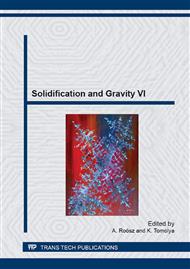[1]
R. Cook, P. S. Cooper, M. A. Kearns, Benefits of master alloy melt treatments in the aluminium foundry industry, TMS Light Metals (1996) 647-654.
Google Scholar
[2]
D. Apelian, G. K. Sigworth and K. R. Whaler, Assessment of grain refinement and modification of Al-Si foundry alloys by thermal analysis, AFS Trans., 161 (1984) 297-307.
Google Scholar
[3]
C. Limmaneevichitr and W. Eidhed, Fading mechanism of grain refinement of aluminium-silicon alloy with Al-Ti-B grain refiners, Mater. Sci. Engg., A349 (2003) 197-206.
DOI: 10.1016/s0921-5093(02)00751-7
Google Scholar
[4]
S. A. Metz, M. C. Flemings, Symposium on Solidification and Materials Processing, USA Publishers, Cambridge, MA, June 28-30, 2000 (2001) 181-188.
Google Scholar
[5]
Dahle, A.K., Tondel P.A., Paradies C.J., Amberg, L., Effect of Grain Refinement on the Fluidity of Two Commercial Al-Si Foundry Alloys, Met. Trans. A., 8A (1996) 2305-2313.
DOI: 10.1007/bf02651885
Google Scholar
[6]
B. S. Murty, S. A. Kori and M. Chakraborty, Grain refinement of aluminium and its alloys by heterogeneous nucleation and alloying, Int. Mater. Rev., 47 (2002) 3-29.
DOI: 10.1179/095066001225001049
Google Scholar
[7]
A Cibula, The mechanism of grain refinement of sand castings in Al alloys, J. Inst. Met., 76 (1949) 321-360.
Google Scholar
[8]
D. G. McCartney, Grain refining of aluminium and its alloys using inoculants, Int. Mater. Rev., 34 (1989) 247-260.
DOI: 10.1179/imr.1989.34.1.247
Google Scholar
[9]
B. S. Murty, S. A. Kori, K. Venkateswralu, R. R. Bhat and M. Chakraborty, Manufacture of Al-Ti-B master alloys by the reaction of complex halide salts with molten aluminium, J. Mater. Process. Technol., 89-90 (1999) 152-158.
DOI: 10.1016/s0924-0136(99)00135-1
Google Scholar
[10]
M. S. Lee and B. S. Terry, Effects of processing parameters on aluminide morphology in aluminium grain refining master alloys, Mater. Sci, Technol., 7 (1991) 608-612.
DOI: 10.1179/mst.1991.7.7.608
Google Scholar
[11]
Q. Zhuaxian, Y. Yaxin, Z. Mingjie, S. K. Grothem and H. Kvande, Preparation of Al-Ti-B master alloys by thermal reduction and electrolysis of B2O3 and TiO in cryolite-alumina melts Aluminium, 64 (1988) 1254-1257.
Google Scholar
[12]
I. G. Davies, J. M. Dennis and A. Hellawell, The nucleation of aluminium grains in alloys of aluminium with titanium and boron, Metall. Trans., 1(1970) 275-280.
DOI: 10.1007/bf02819272
Google Scholar
[13]
P. S. Mohanty and J. E. Gruzleski, Mechanism of grain refinement in aluminium, Acta. Metall. Mater., 43 (1995) 2001-(2012).
DOI: 10.1016/0956-7151(94)00405-7
Google Scholar
[14]
A. L. Greer, P. S. Cooper, M. W. Meredith, W. Schneider, P. Schumacher, J. A. Spittle, A. Tronche, Grain refinement of aluminium alloys by inoculation, Adv. Eng. Mater., 5 (2003) 81-91.
DOI: 10.1002/adem.200390013
Google Scholar
[15]
M. Easton and D. St. John, An analysis of relationship between grain size, solute content and the potency and number density of nucleant particles, Metall. Mater. Trans., 36A (2005) 1911-(1920).
DOI: 10.1007/s11661-005-0054-y
Google Scholar
[16]
Y. Birol, Effect of salt addition practice on the grain refining efficiency of Al-Ti-B master alloys, J. Alloys and Compounds, 420 (2006) 207-212.
DOI: 10.1016/j.jallcom.2005.11.010
Google Scholar
[17]
Sitharam T, Li H., Influence of Ti to B ratio on the ability to grain refine Al-Si alloy J Mater Process Technol, 63 (1997) 585−589.
Google Scholar
[18]
Mohanty P S, Samuel F H, Gruzleski J E., Studies on addition of inclusions to molten aluminum using a novel technique, Metall Trans B, 26 (1995) 103−109.
DOI: 10.1007/bf02648983
Google Scholar
[19]
Kori S A, Auradi V, Murty B S, Chakraborty M., Poisoning and fading mechanism of grain refinement in Al-7Si alloy Materials Forum, 29 (2005) 387−393.
Google Scholar
[20]
Qiu D, Taylor J A, Zhang M X, Kelly P M., A mechanism for the poisoning effect of silicon on the grain refinement of Al-Si alloys, Acta Materialia, 55 (2007) 1447−1456.
DOI: 10.1016/j.actamat.2006.09.046
Google Scholar
[21]
Liu Yuan, Ding Chao, LI Yan-xiang, Grain refining mechanism of Al-3B master alloy on hypoeutectic Al-Si alloys, Trans. Nonferrous Met. Soc. China, 21 (2011) 1435-1440.
DOI: 10.1016/s1003-6326(11)60878-9
Google Scholar
[22]
Jonas Fjellstedt, On crystallization processing of Al-base alloys, Ph. D. thesis, The Royal Institute of Technology, Stockholm, June (2001).
Google Scholar
[23]
Wang X; Brydson R; Jha A; Ellis J, Microstructural analysis of Al alloys dispersed with TiB2 particulate for MMC applications, Journal of Microscopy, 196 (1999) 137-145.
DOI: 10.1046/j.1365-2818.1999.00620.x
Google Scholar
[24]
Jonas Fjellstedt, Anders E. W. Jarfors and Lena Svendsen, Experimental analysis of the intermediary phases AlB2, AlB12 and TiB2 in the Al-B and Al-Ti-B system, J. of Alloys and Compounds, 283 (1999) 192-197.
DOI: 10.1016/s0925-8388(98)00892-5
Google Scholar
[25]
G. K. Sigworth and M. M. Guzowaski, Grain refining of hypoeutectic Al-Si alloys, AFS Trans., 93 (1985) 907-912.
Google Scholar


